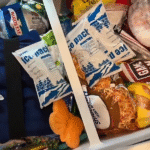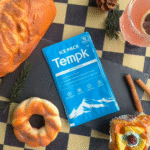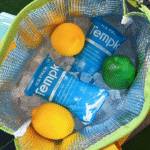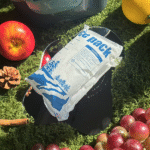Menggunakan paket es kering batu bata es kering sangat penting untuk menjaga suhu sangat rendah selama pengangkutan, namun memilih bentuk yang tepat dan menerapkan penanganan yang tepat bisa jadi rumit. Pasar es kering global diperkirakan akan tumbuh USD 1.66 miliar masuk 2025 ke USD 2.73 miliar oleh 2032, dan pasar refrigeran kemasan rantai dingin diperkirakan akan tercapai USD 2.92 miliar oleh 2032. Lonjakan ini menyoroti perlunya bahan pendingin yang dapat diandalkan untuk vaksin, makanan beku dan sampel biologis. Anda akan mempelajari perbedaan antara es batu kering dan es kemasan, bagaimana memilih dan menggunakannya dengan aman, dan inovasi apa yang muncul 2025.

Perbedaan antara batu bata es kering dan paket es kering – formulir, durasi pendinginan dan kapan harus memilih masing-masing.
Praktik terbaik untuk mengemas dan menangani es kering – berapa banyak es kering yang harus digunakan dan tindakan pencegahan keselamatan.
Tren dan inovasi yang muncul di 2025 – paket yang dapat digunakan kembali, sensor pintar dan sistem hybrid.
Wawasan pasar dan keberlanjutan – pendorong pertumbuhan, kendala pasokan dan inisiatif ramah lingkungan.
Pertanyaan yang sering diajukan – jawaban praktis tentang durasi pengiriman, peraturan dan alternatif.
Apa Itu Batu Bata Es Kering dan Paket Es Kering, Dan mengapa mereka penting?
Batu bata es kering dan paket es kering keduanya terbuat dari karbon dioksida padat (Co₂) itu Subledlimates langsung menjadi gas tanpa meleleh. Artinya tidak ada sisa air, menjadikannya ideal untuk mengirimkan makanan beku, sampel obat-obatan dan laboratorium. Batu bata es kering adalah balok kaku yang menyublim secara perlahan dan memberikan pendinginan yang tahan lama, ketika kantong es kering adalah lembaran fleksibel, pelet atau irisan dirancang untuk pendinginan lebih cepat dan penempatan lebih mudah. Karena suhu es kering kira-kira −78,5 °C (−109 °F), ia menawarkan efisiensi pendinginan tiga kali lipat dari air es. Memilih bentuk yang tepat akan menjaga produk Anda tetap aman, mengurangi limbah dan membantu Anda mematuhi peraturan pengiriman.
Formulir, Ukuran dan Mekanisme Pendinginan
Es kering hadir dalam berbagai bentuk untuk memenuhi berbagai kebutuhan logistik:
| Membentuk | Ukuran Khas | Tingkat sublimasi | Apa Artinya bagi Anda |
| Blok | Besar, lempengan padat | Lambat (48–72 jam dalam kotak terisolasi) | Ideal untuk pengiriman jarak jauh; luas permukaan yang lebih rendah berarti panas diserap secara perlahan. |
| Pelet (beras) | Silinder kecil (~1/8–3/8 inci.) | Cepat (12–24 h) | Memberikan pendinginan yang tepat dan mengisi celah; sering digunakan di laboratorium dan peledakan es kering. |
| Irisan/Nugget | Potongan berukuran sedang | Sedang | Cocokkan ruang sempit; berguna untuk paket kecil atau perlengkapan lapangan. |
| Paket yang sudah jadi | Pelet tertutup dalam kemasan berventilasi | Variabel | Dirancang untuk melepaskan gas CO₂ secara perlahan di sekitar produk, menjaganya tetap dingin tanpa kontak langsung. |
Batu bata es kering berat dan sulit untuk diangkat, tapi mereka mempertahankan suhu lebih lama dari pelet. Paket es kering lebih mudah ditangani dan dapat diatur di sekitar produk yang tidak beraturan, tetapi mungkin memerlukan penggantian lebih cepat.
Tip dan Saran Pengguna Praktis
Untuk perjalanan jauh dan beban berat: Gunakan batu bata es kering atau kemasan industri besar. Sublimasinya yang lambat membuat kargo tetap beku selama berhari-hari.
Untuk pendinginan presisi atau kemasan kecil: Gunakan pelet atau irisan untuk mengisi ruang dan memastikan pendinginan merata.
Gabungkan formulir bila perlu: Pengiriman campuran dapat menggabungkan batu bata untuk barang beku dan paket gel untuk barang dingin.
Kasus aktual: Seorang eksportir makanan laut mengganti es air dengan es kering kecil. Dengan memberi ventilasi pada kotak berinsulasi dan menempatkan kemasan dengan benar, perusahaan mengurangi berat pengiriman sebesar 30 % dan menyimpan fillet ikan dalam keadaan beku 48 jam tanpa kebocoran.
Memilih Antara Batu Bata Es Kering dan Paket Es Kering: Faktor yang Perlu Dipertimbangkan
Pemilihan bahan pendingin yang tepat bergantung pada durasi pengiriman, persyaratan produk dan pengalaman pelanggan. Batu bata es kering unggul untuk jangka waktu lama (48+ jam) dan beban berat; mereka menjaga suhu sangat dingin di bawah −70 °C dan penting untuk vaksin, daging beku atau sampel biologis. Paket es kering bekerja dengan baik untuk perjalanan yang lebih pendek atau paket yang lebih kecil dan lebih mudah ditangani oleh pelanggan. Kemasan gel atau bahan pengubah fasa mungkin lebih disukai bila barang harus tetap didinginkan daripada dibekukan.
Persyaratan Suhu Produk
Produk yang berbeda memiliki kebutuhan suhu yang berbeda:
Barang beku (es krim, hidangan laut, vaksin): memerlukan kondisi yang sangat dingin; es kering menyublim pada suhu −78,5 °C untuk memastikan barang-barang ini tetap beku.
Barang dingin (cokelat, obat-obatan yang membutuhkan 2–8 °C): paket gel atau bahan pengubah fasa lebih cocok karena dapat mempertahankan suhu di atas titik beku.
Durasi dan jarak pengiriman
Pengiriman jarak jauh atau rute melalui iklim hangat lebih menyukai batu bata es kering, yang berlangsung 48–72 jam. Pengiriman lokal atau pengiriman pada hari yang sama dapat mengandalkan paket gel atau paket es kering yang lebih kecil. Es kering dan muatan dengan berat yang sama dapat membuat barang tetap beku hingga lebih lama 48 jam, Dan 1.5× berat mungkin diperlukan untuk 72 jam.
Penanganan dan Kepatuhan Terhadap Peraturan
Es kering diklasifikasikan sebagai Dan 1845 di bawah bahan berbahaya oleh Asosiasi Transportasi Udara Internasional (Iata) dan AS. Departemen Transportasi (DOT). Pengiriman melebihi 5 lbs memerlukan pelabelan dengan “Es Kering (Karbon Dioksida Padat) PBB 1845” dan deklarasi bobot. Paket gel tidak diatur sehingga lebih mudah ditangani oleh pelanggan.
Biaya dan Keberlanjutan
Es kering mudah rusak dan harus diisi ulang untuk setiap pengiriman. Paket gel dapat digunakan kembali dan biayanya lebih rendah, tetapi mereka tidak dapat mempertahankan suhu yang sangat dingin. Paket es kering yang dapat digunakan kembali, muncul di 2025, dapat diisi ulang dengan CO₂ padat beberapa kali dan membantu bisnis menghemat hingga 20 % pada biaya pendinginan sekaligus mengurangi sampah plastik.
Pengalaman Pelanggan
Pelanggan yang tidak terbiasa dengan es kering mungkin khawatir akan radang dingin atau pembuangan. Berikan instruksi yang jelas dan peralatan pelindung saat mengirimkan kiriman es kering. Untuk perlengkapan makan atau pengiriman konsumen, pertimbangkan pendekatan hibrida yang menggunakan es kering untuk komponen beku dan kemasan gel untuk produk segar.
Praktik Terbaik untuk Mengemas dan Menangani Es Kering
Pengiriman dengan es kering memerlukan perencanaan yang matang untuk memastikan keselamatan dan kepatuhan. Gunakan panduan berikut untuk melindungi produk dan staf Anda.
Menghitung Jumlah Es Kering yang Benar
Aturan umum: Menggunakan 1–2 pon es kering untuk setiap 3–4 pon produk.
24jam penerbangan: 15 pon es kering dapat mempertahankan kondisi −70 °C untuk pengiriman 24 jam.
Rasio berat: Setengah dari berat muatan dalam es kering mencakup pengiriman semalam; berat yang sama diperlukan untuk 48 jam, Dan 1.5× berat mungkin diperlukan untuk 72 jam.
Tip Pengepakan dan Isolasi
Kontainer yang sudah dikondisikan sebelumnya: Dinginkan kotak sebelum menambahkan es kering untuk memperlambat sublimasi.
Lapisan dengan benar: Letakkan es kering di atas produk agar udara dingin meresap; gunakan karton atau bantalan untuk melindungi barang yang sensitif terhadap suhu dingin ekstrem.
Ventilasi Kemasan: Jangan pernah menyegel wadah kedap udara; gunakan styrofoam yang dilapisi karton agar gas CO₂ bisa keluar.
Minimalkan ruang kosong: Isi celah dengan bahan isolasi (busa, pelet) untuk mencegah kantong hangat.
Gunakan kemasan luar yang kuat: Karton bergelombang atau kotak plastik tugas berat memberikan kekuatan; hindari drum baja atau wadah plastik tertutup.
Tindakan Pencegahan Keselamatan dan Pertimbangan Peraturan
Kenakan perlengkapan pelindung: Gunakan sarung tangan terisolasi, kacamata dan sepatu kaki tertutup untuk menghindari radang dingin.
Pastikan ventilasi: Satu pon es kering terlepas 250 Liter Gas CO; simpan dan tangani di tempat yang berventilasi baik.
Paket label: Tandai pengiriman dengan “Es Kering (Karbon Dioksida Padat) UN 1845” dan sertakan berat bersih untuk mematuhi aturan DOT/IATA.
Hindari bahan yang tidak kompatibel: Logam, plastik atau kaca dapat retak pada suhu yang sangat dingin; gunakan wadah yang diperuntukkan bagi es kering.
Petugas kereta api dan pelanggan: Berikan instruksi untuk penggunaan dan pembuangan yang aman; staf yang tidak terlatih mungkin salah menangani es kering dan berisiko mengalami radang dingin atau sesak napas.
Pembuangan: Biarkan es kering menyublim di ruang terbuka; jangan pernah membuangnya ke bak cuci atau saluran air.
Kasus aktual: Laboratorium bioteknologi penuh sesak 15 lbs es kering dalam wadah yang sudah didinginkan sebelumnya dengan lubang ventilasi untuk a 24jam penerbangan, pencapaian −70 °C selama transit tanpa penumpukan tekanan.
Kesalahan umum untuk dihindari
Menyegel wadah sepenuhnya – memerangkap CO₂ dan dapat menyebabkan ledakan.
Meremehkan kuantitas es kering – menyebabkan pencairan; sesuaikan dengan suhu sekitar dan waktu perjalanan.
Menghubungi air – mempercepat sublimasi; menjaga es kering tetap kering.
Melewatkan pelatihan – staf yang tidak terlatih mungkin mengabaikan ventilasi dan alat pelindung diri.
Penanganan yang aman, Pengemasan dan Pembuangan
Selain pedoman di atas, memastikan operasi Anda memenuhi standar peraturan:
Klasifikasi peraturan: Es kering adalah Kelas 9 bahan berbahaya (Dan 1845); pengiriman memerlukan pelabelan dan dokumentasi.
Pembatasan transportasi udara: IATA membatasi es kering 200 kg per paket pada pesawat penumpang.
Peraturan pos: AS. Layanan Pos mengizinkan pengiriman es kering di dalam negeri tetapi membatasinya 5 pon per paket, sedangkan FedEx atau UPS mengizinkan pengiriman lebih besar dengan dokumentasi yang sesuai.
Mendidik staf dan pelanggan tentang penanganan yang aman. Sediakan panduan tercetak di dalam kemasan yang menjelaskan cara menangani dan membuang es kering secara bertanggung jawab. Dorong penerima untuk membiarkan es kering menyublim di luar ruangan atau di area yang berventilasi.
Bagaimana Paket Es Kering yang Dapat Digunakan Kembali dan Teknologi Cerdas Bertransformasi 2025 Logistik rantai dingin
Industri rantai dingin berkembang pesat. Tujuan keberlanjutan, kendala pasokan dan kemajuan teknologi mengubah cara perusahaan menggunakan es kering. Di dalam 2025, Paket es kering yang dapat digunakan kembali, Sensor Cerdas, sistem hibrida Dan isolasi yang lebih baik adalah tren utama.
Paket es kering yang dapat digunakan kembali
Paket es kering tradisional hanya sekali pakai. Setelah es kering menyublim, kemasannya dibuang. Fitur desain baru tahan lama, wadah terisolasi yang dapat diisi ulang dengan CO₂ padat. Kemasan yang dapat digunakan kembali dapat mempertahankan suhu −78,5 °C, Mencegah kerusakan air dan dapat digunakan kembali ratusan kali. Laporan bisnis yang menggunakan paket yang dapat digunakan kembali hingga 20 % penghematan biaya pendinginan dan mengurangi sampah plastik. Hal ini membantu memenuhi target keberlanjutan perusahaan dan mengurangi dampak lingkungan dari pelayaran.
Sensor Cerdas dan Pemantauan Suhu
Internet of Things (IoT) teknologi merevolusi logistik rantai dingin. Paket es kering yang cerdas mengintegrasikan sensor yang memantau suhu internal dan mengirimkan peringatan ketika suhu menyimpang dari kisaran aman. Beberapa sistem bahkan mengisi ulang es kering secara otomatis ketika sensor mendeteksi pemanasan. Di tingkat makro, penyedia logistik mengoperasikan menara kendali tempat kecerdasan buatan menganalisis data suhu, memprediksi potensi kunjungan dan merekomendasikan intervensi. Pendekatan proaktif ini mengurangi pembusukan dan meningkatkan kepatuhan.
Sistem Hibrid dan Peningkatan Isolasi
Sistem rantai dingin hibrida menggabungkan es kering dengan bahan perubahan fase (PCMS) atau paket gel. PCM menyerap dan melepaskan panas pada suhu tertentu (misalnya. 2–8 °C atau −20 °C) dan dapat digunakan kembali. Es kering memberikan kondisi yang sangat dingin, sementara PCM mempertahankan zona dingin. Kemasan hibrida memungkinkan pengiriman multi suhu, ideal untuk kargo campuran seperti daging beku dan sayuran segar. Panel isolasi vakum (VIP) juga meningkatkan retensi dingin, memungkinkan perusahaan untuk menggunakan lebih sedikit es kering sambil mempertahankan suhu yang dibutuhkan.
Dinamika dan Keberlanjutan Pasar
Permintaan es kering meningkat di berbagai sektor, tetapi pasokan CO₂ terbatas. Pasar es kering global diproyeksikan akan meningkat tumbuh dari USD 1.66 miliar masuk 2025 ke USD 2.73 miliar oleh 2032, sementara permintaan untuk refrigeran kemasan rantai dingin akan tercapai USD 2.92 miliar oleh 2032. Namun, pasokan hanya tumbuh sekitar 0.5 % per tahun, menyebabkan kelangkaan berkala dan lonjakan harga hingga 300 %. Oleh karena itu, perusahaan berinvestasi pada kemasan yang dapat digunakan kembali, isolasi yang efisien dan pendingin alternatif untuk mengurangi ketergantungan mereka pada es kering sekali pakai.
Tekanan lingkungan juga merupakan faktor pendorong lainnya. Sebagian besar CO₂ yang digunakan untuk es kering berasal dari proses bahan bakar fosil. Produsen sedang menjajaki CO₂ berbasis bio yang ditangkap dari pabrik etanol untuk menciptakan es kering yang lebih berkelanjutan. Lapisan yang dapat terbiodegradasi pada kemasan dan bahan yang dapat didaur ulang juga mengurangi dampak terhadap lingkungan.
Kemajuan terbaru sekilas
Paket es kering yang dapat digunakan kembali: Wadah tahan lama yang dapat diisi ulang dengan CO₂ padat, menghemat biaya dan limbah.
Sensor pintar: Perangkat IoT terintegrasi memantau suhu dan secara otomatis mengisi ulang es kering bila diperlukan.
Solusi hibrida: Menggabungkan es kering dengan PCM atau kemasan gel untuk pengiriman multi suhu.
Panel isolasi vakum: VIP mengurangi perpindahan panas dan mengurangi penggunaan es kering sambil tetap menjaga suhu dingin.
CO₂ dan keberlanjutan berbasis bio: Menangkap CO₂ dari pabrik bioetanol dan menggunakan bahan yang dapat terbiodegradasi untuk menurunkan jejak karbon.
Wawasan Pasar dan Dinamika Sektor
Prospek Pasar Es Kering
Itu pasar es kering global dihargai pada USD 1.54 miliar masuk 2024, dan diperkirakan akan tumbuh menjadi USD 1.66 miliar masuk 2025 Dan USD 2.73 miliar oleh 2032, dengan tingkat pertumbuhan tahunan gabungan (CAGR) dari 7.4 %. Asia Pasifik mengadakan a 32.47 % berbagi 2024, didorong oleh pertumbuhan logistik rantai dingin dan meningkatnya permintaan makanan beku dan obat-obatan. Permintaan juga kuat di Amerika Utara, dimana es kering digunakan dalam pengolahan makanan, penyimpanan vaksin dan peledakan es kering.
Pandemi COVID 19 menyoroti pentingnya es kering dalam distribusi vaksin. Vaksin Pfizer-BioNTech memerlukan suhu yang sangat dingin, menyebabkan kelangkaan sementara dan ketidakstabilan harga. Ketika vaksin baru dan terapi canggih bermunculan, kebutuhan akan bahan pendingin kriogenik yang andal akan tetap ada.
Pasar Refrigeran Pengemasan Rantai Dingin
Itu pasar pendingin kemasan rantai dingin (yang termasuk paket gel, batu bata busa dan zat pendingin lainnya) adalah USD 1.57 miliar masuk 2024 dan diproyeksikan ke mencapai Rp 1.69 miliar masuk 2025 Dan USD 2.92 miliar oleh 2032, dengan CAGR sebesar 8.14 %. Eropa memimpin pasar dengan a 31.85 % berbagi 2024. Pertumbuhan didorong oleh kebutuhan sektor farmasi akan kemasan dengan pengatur suhu untuk melindungi produk sensitif.
Inovasi produk dan bahan pendingin yang berkelanjutan adalah kuncinya. Perusahaan menawarkan paket gel yang terbuat dari laminasi nilon tahan tusukan dan bahan tahan lama lainnya. Inovasi ini mengurangi biaya operasional dan memenuhi persyaratan peraturan untuk integritas kemasan.
Faktor Penghambat dan Peluang
Pasokan dan harga CO₂ yang fluktuatif dapat menghambat pertumbuhan. Ketersediaan CO₂ bergantung pada proses industri seperti produksi etanol dan gas alam; fluktuasi menyebabkan kekurangan pasokan dan lonjakan harga. Faktor geopolitik dan pembatasan ekspor juga dapat mengganggu rantai pasokan. Untuk memitigasi risiko, perusahaan mendiversifikasi sumber CO₂, jelajahi penangkapan berbasis bio dan berinvestasi dalam isolasi hemat energi.
Pertanyaan yang sering diajukan
Pertanyaan 1: Apa perbedaan antara es batu kering dan es kering??
Batu bata es kering berukuran besar, blok kaku yang menyublim secara perlahan dan memberikan pendinginan yang tahan lama (48–72 jam). Paket es kering terdiri dari pelet atau irisan yang dibungkus dalam kemasan berventilasi; mereka mendingin lebih cepat (12–24 jam) dan lebih mudah untuk diposisikan di sekitar produk. Pilih batu bata untuk perjalanan jauh dan bungkus untuk perjalanan pendek atau ruangan kecil.
Pertanyaan 2: Berapa banyak es kering yang saya butuhkan untuk pengiriman?
Menggunakan 1–2 pon es kering per 3–4 pon produk. Untuk pengiriman 24 jam, sekitar 15 lbs es kering mempertahankan suhu −70 °C. Berat es kering dan muatan yang sama membuat barang tetap beku 48 jam, Dan 1.5× beratnya meliputi 72 jam.
Pertanyaan 3: Apakah ada peraturan untuk pengiriman es kering?
Ya. Es kering diklasifikasikan sebagai Dan 1845; pengiriman harus diberi label “Es Kering (Karbon Dioksida Padat) UN 1845 ”dan termasuk bobot bersih. IATA membatasi es kering 200 kg per paket pada pesawat penumpang. AS. Layanan Pos memungkinkan pengiriman 5 pon atau kurang.
Pertanyaan 4: Untuk apa inovasi terbaru dalam pengiriman es kering 2025?
Paket es kering yang dapat digunakan kembali, Sensor berkemampuan IoT, sistem hibrida yang menggabungkan es kering dengan bahan pengubah fasa, dan panel isolasi vakum mengubah logistik rantai dingin. Inovasi ini mengurangi biaya, meningkatkan stabilitas suhu dan mendukung tujuan keberlanjutan.
Pertanyaan 5: Bisakah saya menggabungkan es kering dengan kemasan gel?
Ya. Kemasan hibrida menggunakan es kering untuk menjaga barang beku tetap sangat dingin, sedangkan kemasan gel atau PCM menjaga zona dingin. Pendekatan ini ideal untuk pengiriman campuran, seperti perlengkapan makan dengan protein beku dan produk segar.
Pertanyaan 6: Dry ice tahan berapa lama di pengiriman?
Es kering biasanya bertahan 18–72 jam, tergantung pada bentuknya, kuantitas, isolasi dan suhu lingkungan. Blok bertahan lebih lama dari pelet; lebih banyak isolasi dan jumlah es kering yang lebih besar memperpanjang durasi.
Pertanyaan 7: Apakah es kering ramah lingkungan?
Es kering sendiri adalah CO₂ yang jika tidak dilepaskan ke atmosfer. Namun, pasokan sering kali berasal dari proses bahan bakar fosil. Produsen sedang menjajaki penangkapan CO₂ berbasis bio dan kemasan yang dapat digunakan kembali untuk mengurangi jejak karbon. Dengan mengadopsi paket yang dapat digunakan kembali dan isolasi yang efisien, Anda dapat mengurangi limbah dan penggunaan energi.
Ringkasan dan Rekomendasi
Kunci takeaways: Batu bata es kering dan paket es kering merupakan alat penting dalam logistik rantai dingin. Batu bata memberikan pendinginan yang tahan lama, ketika paket menawarkan fleksibilitas. Perhitungan kuantitas yang tepat, pengemasan berventilasi dan pelatihan keselamatan memastikan pengiriman yang aman dan patuh. 2025 inovasi – paket yang dapat digunakan kembali, Sensor Cerdas, sistem hybrid dan VIP – meningkatkan efisiensi dan keberlanjutan. Pasar global untuk es kering dan zat pendingin rantai dingin terus berkembang, namun kendala pasokan dan masalah lingkungan memerlukan strategi proaktif.
Langkah selanjutnya:
Nilai persyaratan suhu produk Anda: Tentukan apakah barang Anda perlu dibekukan (−70 °C) atau dinginkan (2–8 ° C.) kondisi dan pilih batu bata es kering, paket atau solusi hybrid yang sesuai.
Hitung kuantitas es kering: Gunakan 1–2 pon untuk setiap 3–4 pon produk; sesuaikan berdasarkan durasi dan suhu sekitar.
Terapkan pengemasan dan pelabelan yang aman: Gunakan ventilasi, wadah terisolasi, memakai alat pelindung, dan beri label pada kemasan “Es Kering (Karbon Dioksida Padat) UN 1845” dengan berat bersih.
Mengeksplorasi 2025 inovasi: Belilah paket es kering yang dapat digunakan kembali, sensor pintar dan VIP untuk mengurangi biaya dan dampak lingkungan.
Latih staf dan informasikan kepada pelanggan: Berikan instruksi yang jelas untuk penanganannya, ventilasi dan pembuangan untuk mencegah kecelakaan dan meningkatkan kepuasan pelanggan.
Tentang tempk
Kami Tempk, penyedia terkemuka solusi rantai dingin. Portofolio kami meliputi batu bata es kering, Paket es kering dan wadah berinsulasi inovatif yang menjaga suhu sangat rendah. Dengan R&D fasilitas Dan sertifikasi mutu, kami terus mengembangkan produk ramah lingkungan dan dapat digunakan kembali yang membantu klien mengurangi biaya dan memenuhi tujuan keberlanjutan. Apakah Anda mengirimkan vaksin, makanan laut atau peralatan makan gourmet, Kami dapat menyesuaikan solusi pendinginan yang sesuai dengan kebutuhan Anda.
Panggilan untuk bertindak: Siap mengoptimalkan rantai dingin Anda? Hubungi pakar kami di Tempk untuk mendapatkan panduan khusus dalam memilih batu bata es kering atau paket es kering yang tepat. Tim kami dapat membantu Anda menghitung jumlah, merancang kemasan dan menerapkan teknologi terkini. Jangkau sekarang dan lindungi kiriman Anda dengan percaya diri.























